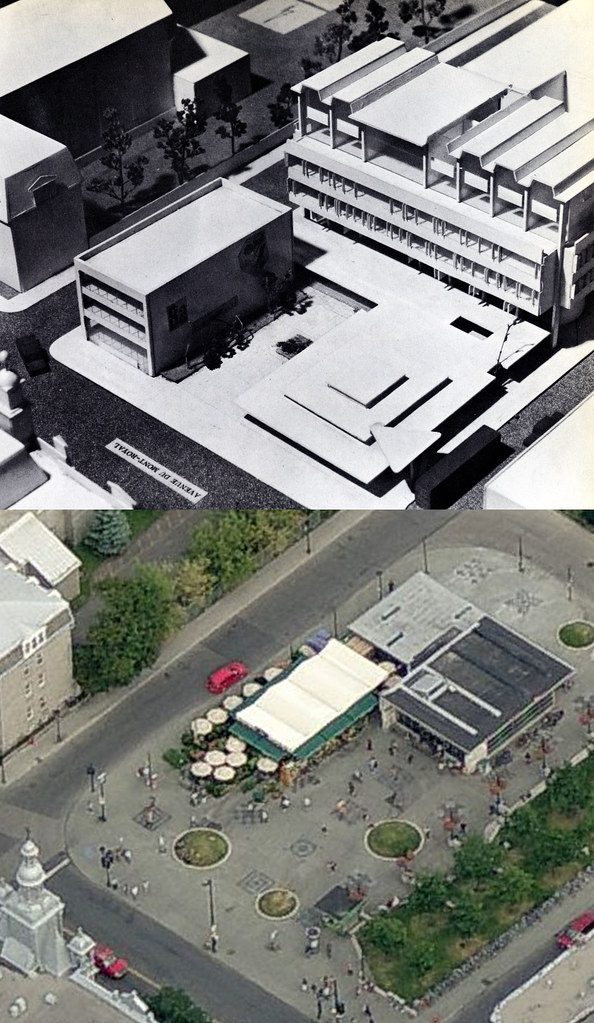La vision de 1965 et l’état des lieux en 2008
La caisse populaire, située à l’extrême gauche du terrain, fut démolie en 1999.
Sources :
Photo : Armour Landry, publiée dans le livre KNOTT, L. Léonard, Montréal l’âge d’or = the golden years, Toronto, 1965, 181 p.
www.bing.com


7 comments
Je ne vois pas bien sur la projection de 1965 ce qui était prévu derrière la station (au sud, entre Mont-Royal et Marie-Anne).
La Caisse pop est située en face (côté nord de l’avenue Mont-Royal) maintenant. Un peu dommage de ne pas avoir densifié le développement, avec des habitation au-dessu du métro. On aurait pu densifier l’emplacement tout en plantant des arbres et de la verdure.
I like the stations as it exists now. It has evolved over the years into something that can only be achieved by piecemeal growth and improvement. The square is always busy, it’s a good meeting place and the fruiterie-cum-sugar shack is an inspired touch that adds yet another dimension to the space (and a seasonal one at that). If someone were to ask me where the centre of the Plateau is, I’d point them here.
It’d probably be a construction nightmare to lease the air rights over the metro itself, but what about over the bus lane behind. There’s no public access, so it’s just wasted space as far as the public are concerned.
It would be a brilliant spot for a café-terrasse – think of the people-watching!
Guillaume- qu’est-ce qui est arrivé à l’immeuble derrière l’édicule? Saviez-vous pourquoi ça n’a jamais été construit, ou qui sont les architectes derrière ce plan? C’est une forme pas mal intérressante…
I also like the station just as it is now. As it is now, it’s a public square and market, the hub of the Plateau Mont-Royal. Also, most tourists who want to visit the Mountain tend to go to station Mont-Royal and walk up rue Mont-Royal to Jeanne-Mance park.
Rue Mont-Royal really should be turned into a pedestrian street, at least the section between Papineau and St-Laurent. This section is so busy all year round that it takes the bus almost 20 minutes to travel 10 blocks, it’s actually faster (or just as fast) to walk. The city could retain north-south routes crossing rue Mont-Royal, like Prince Arthur, to allow (vehicular) traffic flow.
Niomi, I am very much in favour of walkable cities, but I’m also for cities for all ages and abilities. A pedestrian street also requires some form of transport (Projet Montréal and others advocate a tram) so frail older people and parents with small children can also access this area. There also has to be some means of delivering goods to the many businesses along the street – this can be restricted to certain times. We also have to take harsh winters into account.
I see your point, Maria, but the city core itself is about 25%+ pavement devoted to streets. So much of the city is taken up with streets that there isn’t enough room for buildings, themselves. There are enough streets in Montreal to satisfy every last car, bus, motorcycle, and bicycle. What we don’t have enough of is streets devoted to pedestrian traffic. There are *several thousand* streets in Montreal for motor vehicles, and maybe a dozen pedestrian streets.
Besides, I see no reason why rue Mont Royal can’t be turned into a pedestrian street with only bus and taxi access, like Granville and Robson streets in Vancouver. As for shipping and transport trucks, they can use the back alleys, which they tend to do anyway.
Rue Ste-Catherine should also be a pedestrian street.
The only real way to eliminate traffic is to eliminate motor vehicle access to the street the traffic is on.
“Trying to cure traffic congestion by adding more capacity is like trying to cure obesity by loosening your belt.”